In today's TPOM, we are going to take a look at building out our causal maps. It is possible, if not probable, that we will have some fun and learn a lot in the process.
Causal Mapping
Let's take a look at a causal map that involves a storyline. I call this John Causes the End of the World. We will be working on this causal map for quite a long time. The important thing, for now, is to grasp that we are dealing with John's drive to the doctor's office. John has three possible routes he can take to the doctor's office, and each route represents an entirely different timeline and, therefore, causal stream. The timelines, which are the causal streams, are on a one-to-one correlation to the routes, i.e., route 1 = timeline 1, etc.
Branching
With each new thought John has, he will generate a different causal stream even when some of his answers are the same between streams. The important thing to get is that every branch is a branch from X causal stream and that there are multiple branches from every new branch. These nested or fractal branches represent the next choice state within that causal matrix, what happens when each is followed, and how they can ultimately yield various outcomes over time. It is interesting because each branch has similarities and differences, and they represent paths not taken by Y1's timeline self, or in other words, John's actual lived experience rather than the mathematical probabilities of potential existences, which you would ultimately see played out if the multiverse scientists turn out to have the correct observational stance on reality or realities.
Note when dealing with the multiverse concept or with slices of time in Einstein's universe, I deal with the slices and the whole in just that way, which means that there are slices or vectors one can potentially take through the space-time continuum and that there is a grand continuum through which to take such vectors of travel.
Each branch, thus being a different subdivision of space-time, means that John's experiences will not all have the same sequential structure. However, they will map to each other in perfect parallel at the observational level of the grand continuum.
The Grand Continuum
The grand continuum is what is being sliced. Then if that is true, and it is true, how is there a grand continuum that has any meaning in the first place? This will attend to Einstein's relativistic mechanical model that states, in brief, that time is relative. How, then, can time be relative and there be a grand time continuum? I do not pretend this is an easy question to answer, and for now, I will leave it with a teaser answer, which is as follows: it all deals with perspective, capacity, and observational positioning. A cat simply will not know certain things about reality that you know without even trying to know. In this regard, I am only concerned with the theoretical and have no care whatsoever for the practical, as the practical could be bounded by, well, us. A fish has his or her medium of existence. Don't you love a little mystery in life? I know I do. Also, this material is not easy, and there is much disagreement around it, so I could be wrong about what I am going to bring forth in the later installments, but then again, I could be right.
With our little causal map, we will have the observational capacity to see all of John's world and all of his potential timelines (hypothetically speaking), starting at the four-way stop and his decision to turn left, right, or continue going straight.
Types of Causal Maps
With our observation of John, we are watching a causal outcropping series form starting at a specific moment in his life. Therefore, we are mapping from that moment in time multiple timelines as they outcrop through time. This will allow us a very smooth experience as we will be able to observe the causal stream as it forms with zero pressure to solve an event series or problem that has already happened. This is a fictional time-forward causal map.
Much of the time, we humans have to deal or have the need to deal with a causal map we are attempting to observe or map for a generative event in the past. For example, we might want to understand exactly how Hitler came to power. If we have the time and capacity, we could indeed put together a map that would agree with reality to such an extent that we could ultimately grasp the local causal structures or proximal causal structures that brought about his rise. As we saw with the earlier swing set causal stream, all of these streams, if done to perfection, will flow back before X person's creation or inception into this universe. It would, in fact, to be complete, flow back to the inception of the universe itself and likely before. This is why I was careful to note that "local causal" is what we were dealing with in the above, as distal causal can be a real issue.
A more simple version of this, though not without its problems, would be the breaking of a flow in data. We would need to diagnose the flow issue or issues and use causal thinking to bring us back to the source of the issue, and this would be done, at least often, via understanding the causal stream and being able to follow it in reverse to understand better what happened and why. Now, this may not be understood by the technician tasked with fixing the problem, but rest assured that someone had to use causal thinking in order to ultimately grasp the original occurrence of that type of problem. The kind of map that deals with this process is a factual time-reversed causal map.
The Why and Bottlenecking
Once understood, it is not essential or even practical for every technician to have to trace causal structures. What is often the case is that the technician is taught how to diagnose and fix X problem via symptoms and not via a complete understanding of the situation as it exists in reality. If every technician had to do the ultimate level of causal dissection required to get to this level of the reality of every occurrence of a problem, the world would bottleneck in a rapid fashion.
When the core structural analysts have the problem within their understanding, they generate what is effectively a probabilistic system of inferences that are then taught to the technician and work basically as heuristical devices or as a form of diagnostic algorithm. The end result of this is that the problems get solved, and our data streams function reasonably well.
This is also how much of the medical system operates. Your general M.D. does not have the time for that type of causal thinking. What they do have the time for and what they do effectively is to observe via those heuristical models and move you on to a specialist who can then deal with deeper issues of pathology, diagnosis, causal inference, inductive reasoning, etc. Provided all of those things go well, and they frequently do not (especially due to outside interference into the system by interests that are not conducive or are amenable to healing patients), the issues should be resolved if possible.
John Causes the End of the World
The above is a macro view of John's timeline to date.
Let's start with John's start.
On his way to the doctor.
The options states present themselves, and the timeline trifurcates.
Timeline no.1: John makes a right turn. The effect (influence) of that right turn is his choice to listen to relaxing music.
Timeline no.2: John makes a left turn. The effect (influence) of the left turn is also to listen to music, but this time, John is going hardcore with Meshuggah.
Timeline no.3: John goes straight ahead. The effect (influence) of going straight through the intersection is that John decides to sit in silence and to think while driving.
John’s decision to relax to music sets up another trifurcation. Each line has its own causal stream.
John’s decision to listen to Meshuggah generates another trifurcation. Carefully note each of his thoughts and feelings as they propagate out the new timeline.
John’s decision to go straight forward at the intersection and to think rather than listen to music generates the following trifurcated timelines. We now have three timelines, each trifurcating into three more timelines with a total of 9 operational timelines.
John’s causal stream no.1, now trifurcated again, yields the following timelines and cause and effect streams.
John’s causal stream generates another series of option states, out of which John's choices generate the next causal trifurcation. We are now at John’s third trifurcation along timeline no.1. Note the flow of his thinking, choice states, and the places he tends to spend his mental energy. This is not at all unlike how we go through our daily lives. What happens if you don’t just read this but study it and contemplate what is happening here as if it were your reality? I highly suggest you do that and that you take the time to note the differences as well as the similarities.
Here, we see John’s timeline no.1 out to its third trifurcation. All of the last three are outcropped so that we can see the parallels and the individual fractal or nested causal flows.
Final Thoughts
We will leave our little story here for now. We made it through the causal stream for timeline one out to three trifurcations from our starting point. Though it was a very short period of John's life, if we reflect upon how each little thing influences the next thing onward ad infinitum. This influence is not only localized to one of us, but it is operational with all of us in real time. Each person that exists is not only a node in the grand causal matrix, but every single thing is also part of this matrix. Think about this for a moment: every single constituent of matter that exists, every quantum particle, all of the total of what “is,” constantly acts and interacts in and through the cause and effect matrices generating the life events we all experience every day. We are all living within a vast cause-and-effect matrix that is mind-bogglingly complex. If the realization of that reality, which is reality, doesn't get you excited, you may want to check your pulse because you may be a zombie.
We will continue.
B.S.R.






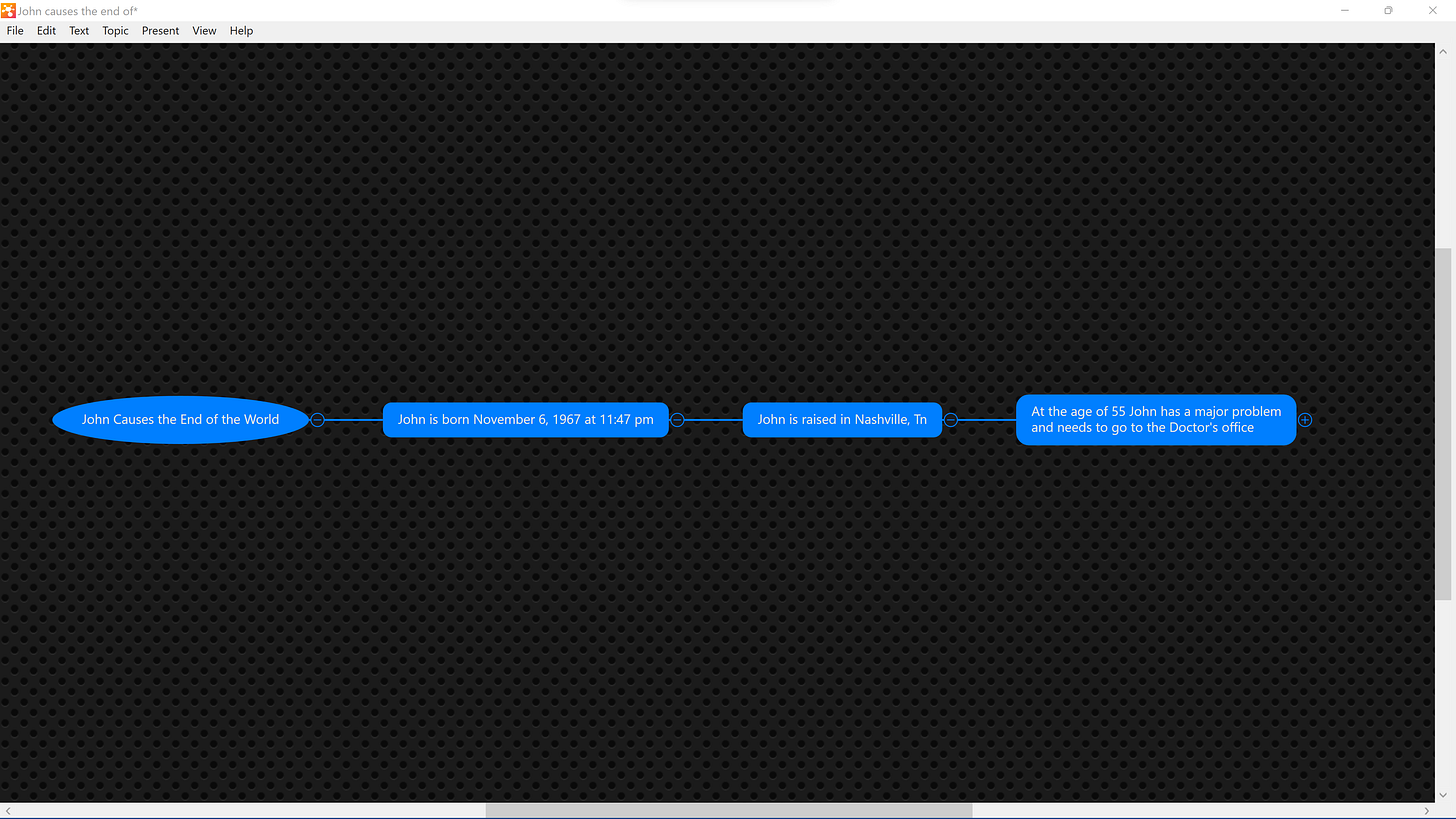




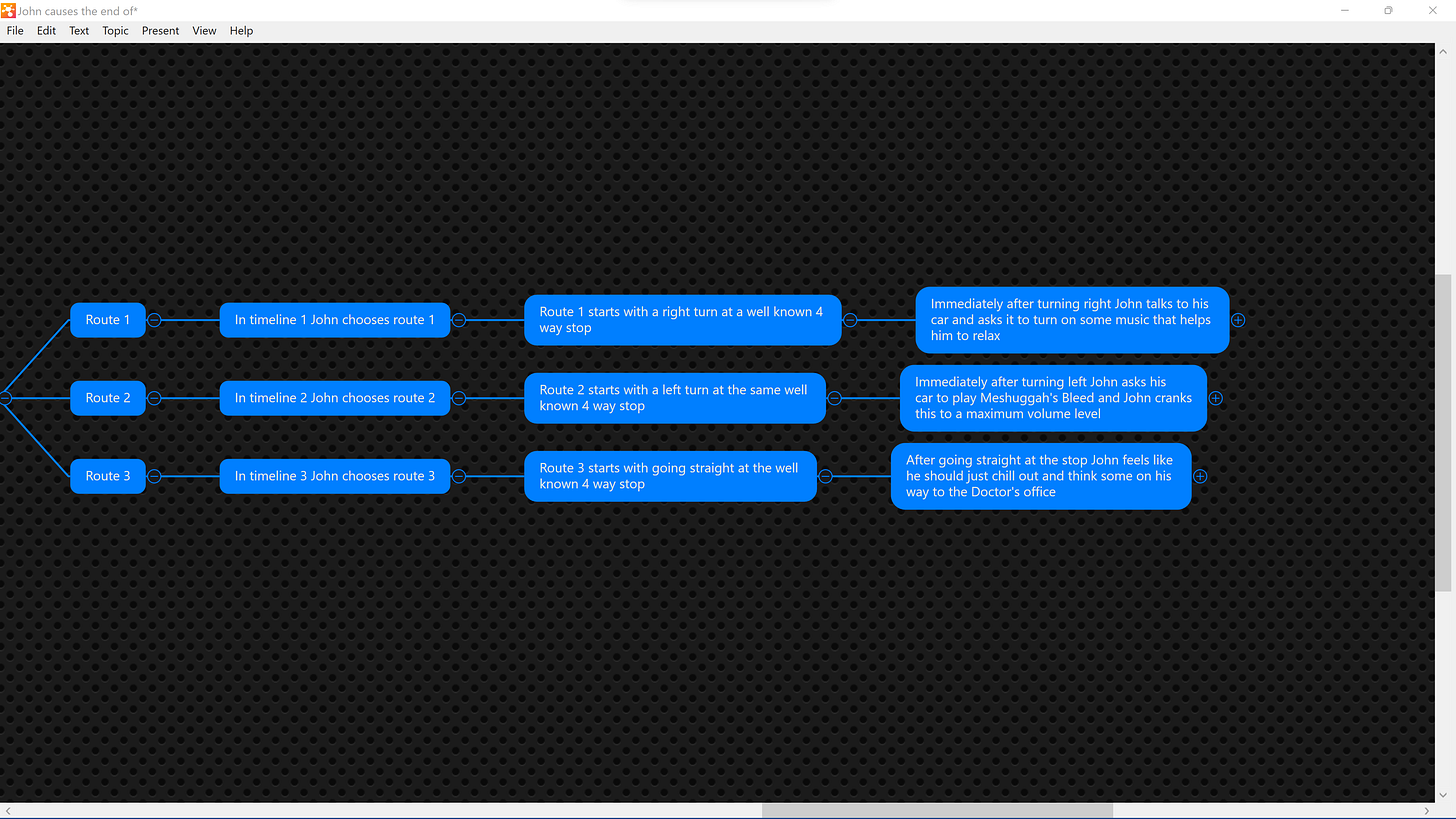

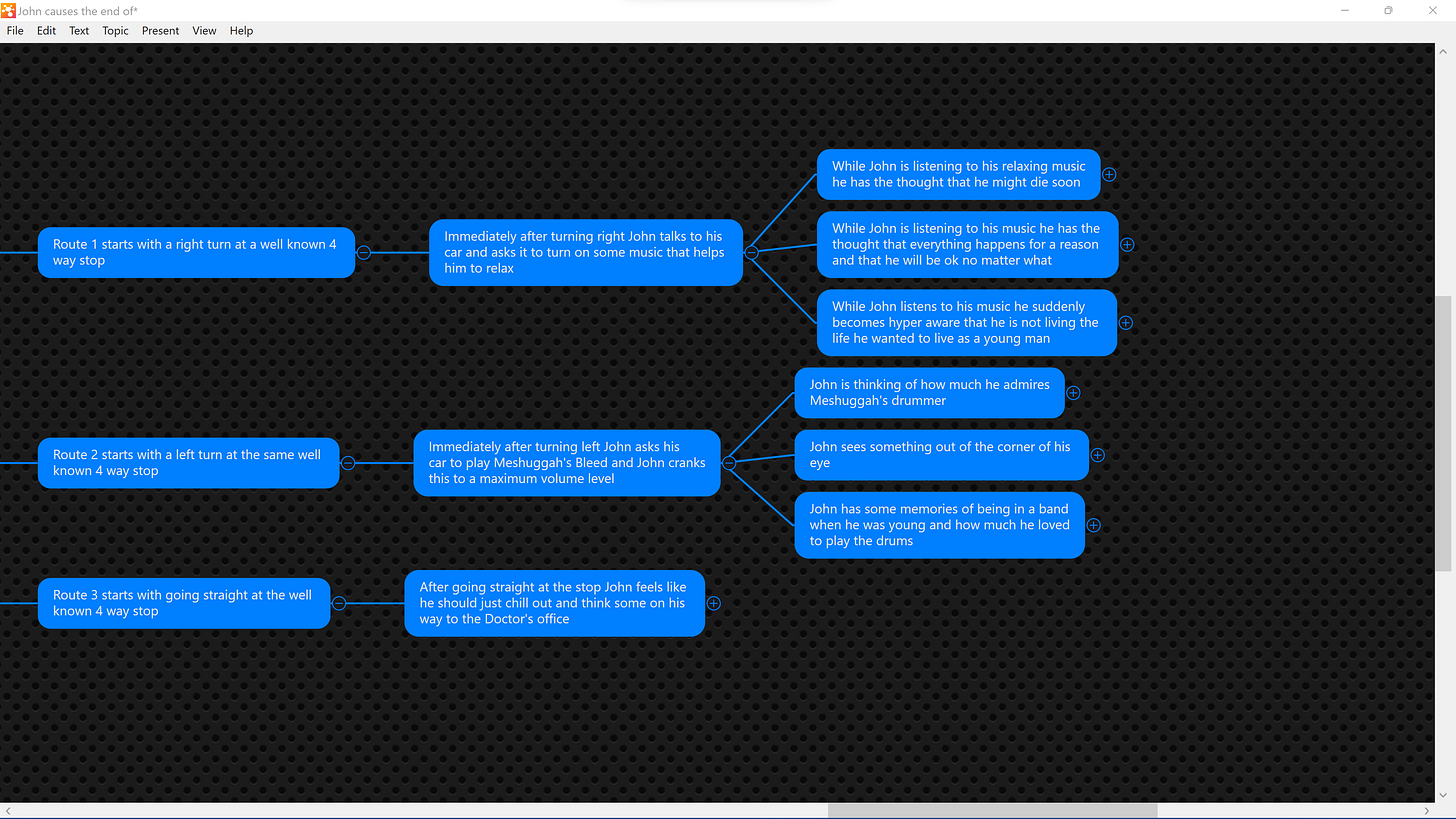

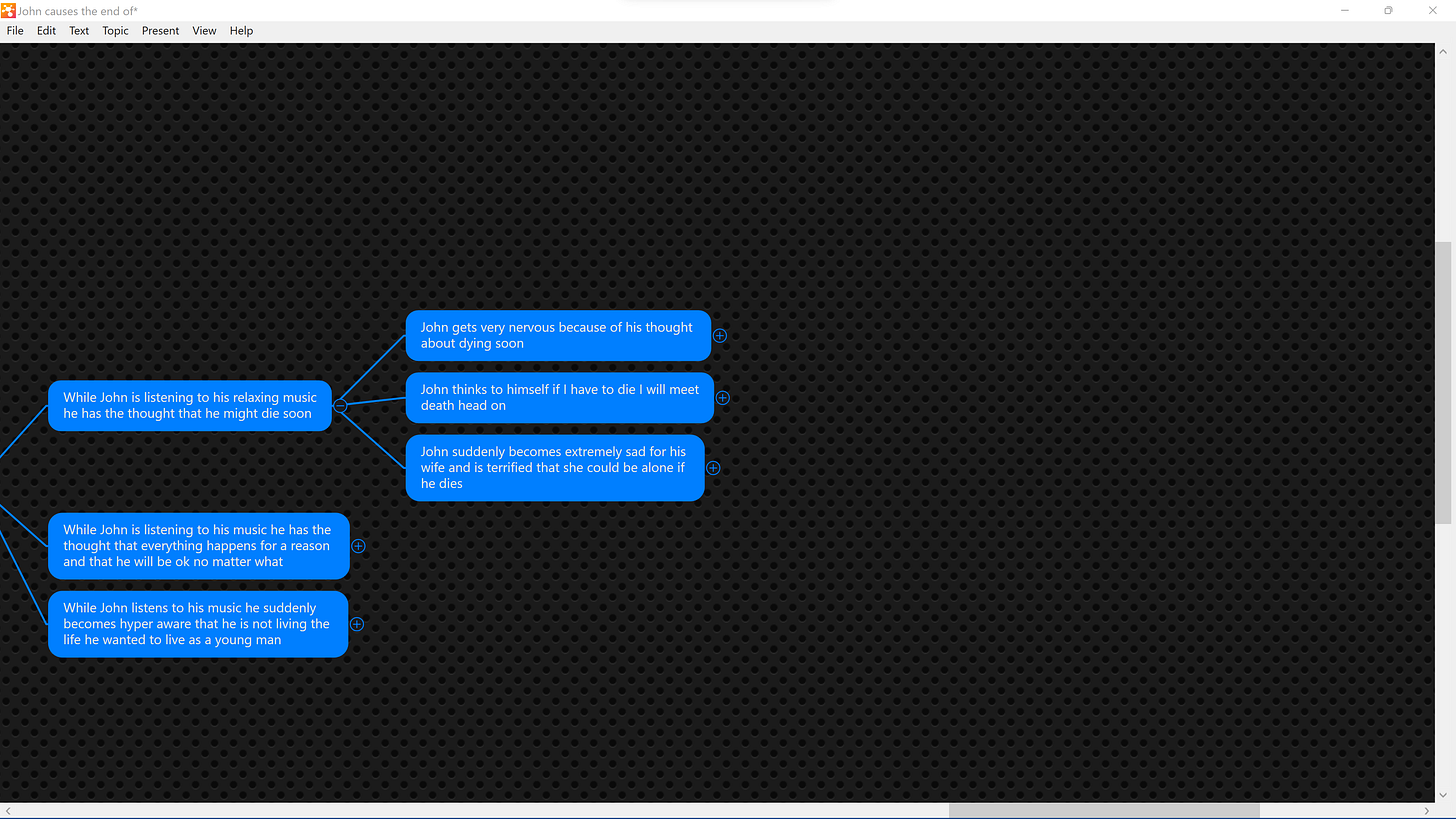
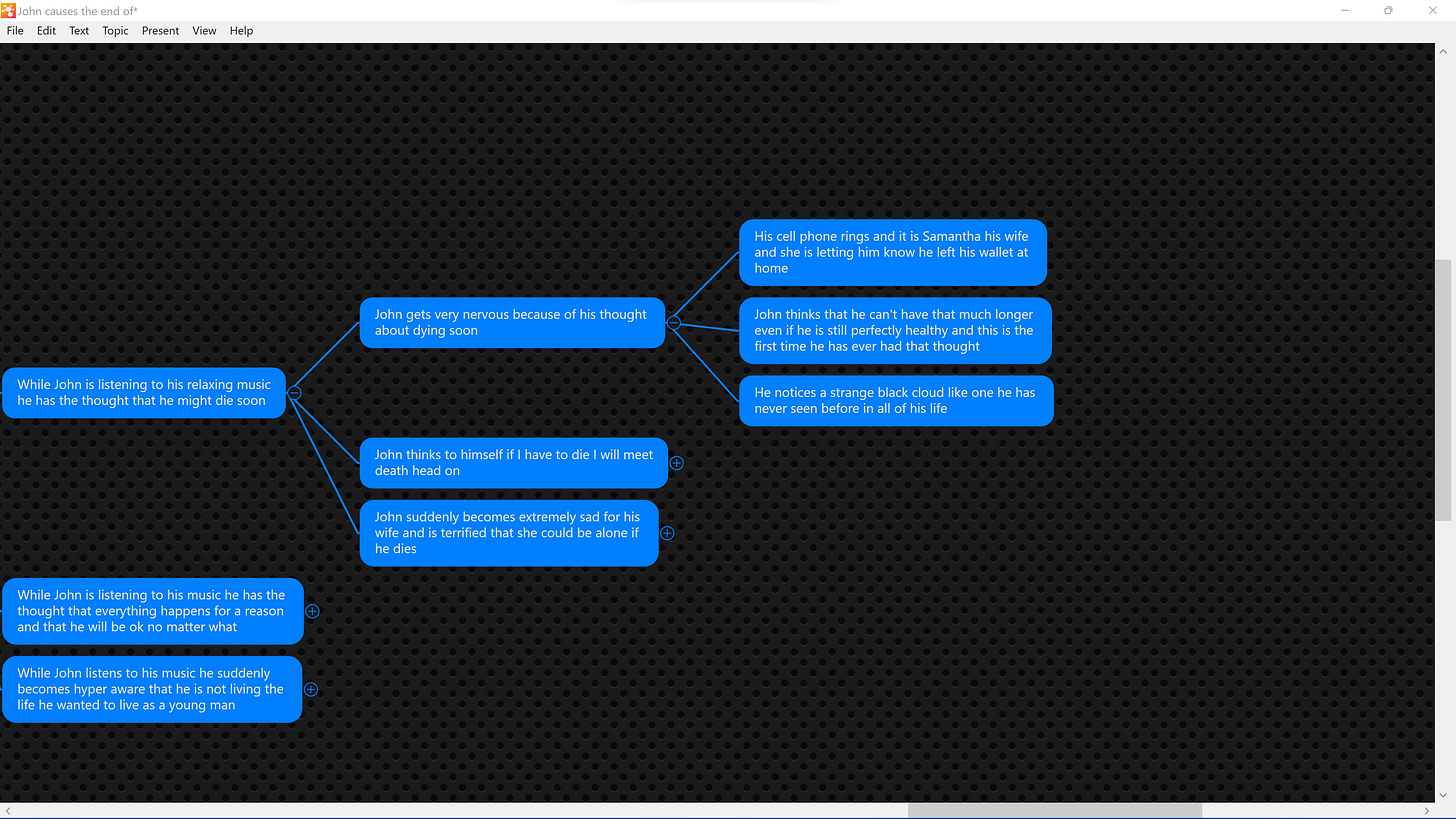
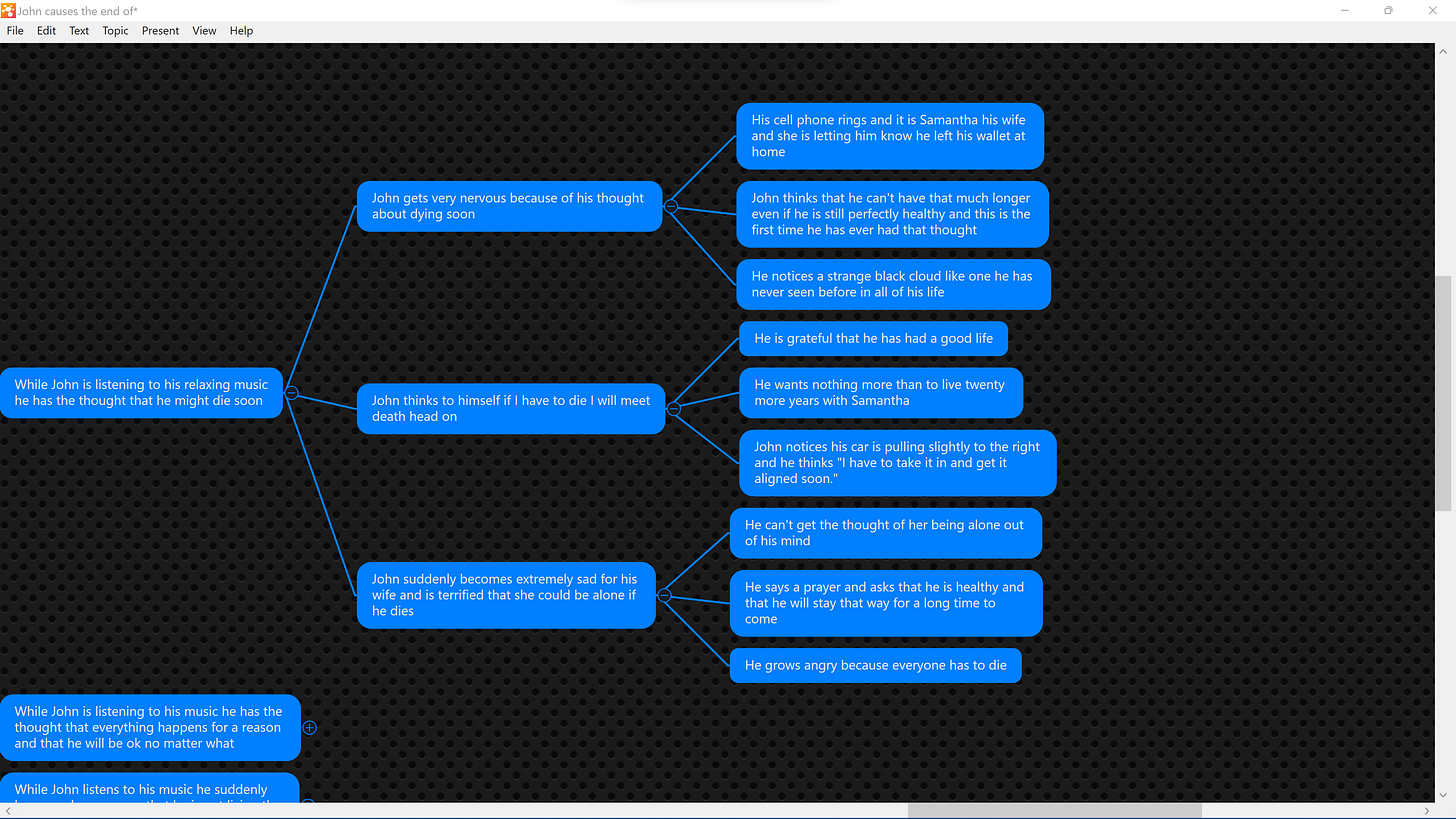
This, like all of these posts, is utterly astounding to consider. I kept thinking of the phrase, "there's more than one way to ______". While this phrase has truth to it, it reduces everything to a heuristic, even if a helpful one. In your maps, John's wallet being left behind manifested in multiple ways depending on the causal stream. This to me is fascinating. A real thing happened (wallet forgotten) and that manifested into the infinite causal continuum of infinite outcroppings. The juxtaposition of past events into the infinite. So even though there may be "more than one way to _____", the path travelled to get there matters tremendously. And that path depends on every choice one makes and every choice ever made. It is motivating to me to consider my choices more deeply.
It was interesting thinking about some of the overlapping concepts and layering going on here with some of the previous posts, specifically your use of the causal stream and causal matrix. It seems like there is a lot of shared ground between a lot of these terms and major Venn-diagramming going on. For instance, all of this brings new meaning to me for the statement, "you don't have to know everything to know something." And also your example of the doctor using a heuristical process with their patient to get them to a specialist brought to mind a lot of that prior material well, including how the errant use of heuristics can bump us up against unknown unknowns, or known unknowns. But, with a causal map, that would ideally help to identify where those issues arose at least in retrospect.